The Grand Concourse runs up the western end of the Bronx like a zipper. Unzip it and you will find Bronx past, present and future: the grand visions of a suburban borough for the wealthy, that turned into a gritty, urban superhighway from Yankee Stadium to Van Cortlandt Park. FNY has been covering the Concourse from the beginning and the second ForgottenTour took place here on July 18, 1999. This was once of the craziest tours FNY ever ran — we were helping author Stuart Miller research the version of The Blue Guide to New York that would come out the next year (it turned out to be the final comprehensive guide in that series) and eventually we split into two separate parties. My end of the schism ran into a thundershower and a parade — at the same time — on the Concourse, and somehow we finished up north in Norwood, while we watched the Yankees’ David Cone finish a perfect game on a bar TV. And, it was the hottest day of the summer.
In 2009 The Grand Concourse celebrated its centennial. I purchased an excellent book, Intersections: The Grand Concourse at 100 (Fordham University Press, 2009) a comprehensive look at the history and construction of the roadway, a look at highlights along the road and a look at plans for its future. Reading the book inspired me to take anew look at the Concourse as it enters a new century. There are plenty of new buildings (some great, some, not as). The most comprehensive look t the Concourse takes place in the book, but I did a survey myself, which will appear in two parts. This page concerns the first half of my walk from East 138th to East 181st in Tremont.
Eleven lanes wide from 161st Street north to Mosholu, the Grand Boulevard and Concourse (shortened to Grand Concourse for the benefit of sign makers and cabbies) was built, from 161st Street north, in 1909 by engineer Louis Risse. In 1927, it absorbed Mott Avenue, which ran from 138th north to 161st, and the older street was widened. The Grand Concourse became the Bronx’s showpiece as the Bronx County Courthouse, Yankee Stadium, and an array of elegant apartment buildings were constructed along its length. The Concourse and surrounding streets are a wonderworld of magnificent apartment architecture. Most of the grand apartments were built from 1925-1940. The dominant style is Art Moderne, a streamlined style offshot from Art Deco. In that era most of the Concourse’ residents were Eastern European and Jewish, but in the late 1960s and early 1970s demographics changed, as Co-Op City near the Westchester county line was built and the overall rush to surburbia spurred a move out of the city. Today the Concourse is home to a Latino and Caribbean-American population, and the architecture is seemingly eternal.
The Concourse occupies a lengthy ridge in the southwest Bronx, which gave engineer Risse an opportunity to innovate. Major east-west roads that were already established, like Tremont Avenue and Burnside Avenue, were placed in underpasses under the Concourse, while in other cases, the Concourse itself moves under the cross road, as it does at Fordham Road. Goods were much more easily transported without the logjams and traffic tie ups that such divisions made possible (in the Concourse’s early days, at least). Major schools relocated their campuses nearer the great road. Yankee Stadium was built a block away in 1923 and great hotels accompanied it — visiting clubs, as well as a few Yankees, stayed at the Concourse Plaza Hotel.
Risse (1850-1925) first envisioned the Concourse in the 1870s, when he was in his twenties. He lived to see a scaled-down version of the road become a reality. In the 1870s, the auto was still science fiction, and Risse’s vision encompassed horse drawn carriages pleasantly clomping up and down tree-lined, shady express route (much like Olmsted and Vaux’ original plans for Ocean and Eastern Parkways in Brooklyn). Detailed plans were drawn up in 1892 with the aid of Louis J. Heintz, who died at age 31 and did not see the plans realized, and Louis F. Haffen, who after succeeding Heintz as Commissioner of Street Improvements, oversaw the Concourse’s construction from 1902 to 1909 as Borough President. Remember, at the same time, the IRT subway, then under private ownership, was beginning to tunnel lines and stretch els from the heart of Manhattan to the Bronx and Brooklyn as well, and it was the beginning of a grand era of road building that would continue through most of the 20th Century under the guidance, some say dictatorship, of NYC road czar Robert Moses, who rose to prominence in the LaGuardia era. It was also the beginning of an amazing era of public transportation construction. Observing in the early 2010s, we can only marvel at the pace on which these great public works were constructed one century ago.
With an emphasis on bicycling and other non-combustion transportation in the early 2010s, will bike and pedestrian lanes come to the Concourse? For some, that would be Grand.
I began my Grand Concourse walk at its southern end, at East 138th and the Major Deegan Expressway. It is an inauspicious beginning for the big road in a nondescript area. The drab stretch was enlivened by light green signs for the Tree Museum, a public arts project curated by Katie Holten that was on the Concourse from June 2009-February 2010 as part of its centennial celebration.
[Katie Holten] has marked out 100 trees along the Concourse, which is about four and a half miles long. Each one will have a sign that gives a phone number and a code to listen to short recordings of people speaking about the Bronx, their lives and their work. The tree museum will open on June 21, [2009].
Tree No. 39, a honey locust at Marcy Place, will feature Jose Ortiz of the percussion group BombaYo. At another honey locust, No. 52, at 175th Street, Lurry Boyd, who grows peaches and strawberries in a community garden, will narrate. In Poe Park, a London plane tree (No. 75) will connect listeners to the story of the park, a former apple orchard that is now home to a cottage where Edgar Allan Poe lived. People often danced around the park’s bandstand at night, as Lloyd Ultan, the Bronx borough historian, tells it, including two sisters named Clooney. One of them was the singer Rosemary Clooney, aunt of the actor George Clooney. Jim Dwyer, New York Times, 6/7/09
Unfortunately the Tree Museum wasn’t permanent but it still has an online presence.
PS 31 is a landmarked building on the west side of the Concourse from East 144-146 Streets constructed by NYC’s pre-eminent schools architect, Charles .B.J. Snyder, from 1897-1899. In October 2009, when I passed by it was in the throes of a complete renovation and most of it was shrouded, and it looks as if it was undergoing a complete rebuild. The school is full of the ruffles and flourishes common to its period, with turrets, gables and a general elaborateness. Once called The Castle on the Concourse, it was a dry run, it seems, for Snyder’s Bronx masterwork, Morris High School in Morrisania.
Hostos Community College, named for Eugenio María de Hostos, a Puerto Rican educator, writer, and patriot, was instituted in 1968 in response to demands from the South Bronx’ Latino community for a local college. It originally met in a former tire factory in 1970, and became part of the City University of New York. The present facility, built in the early 1990s, is on both sides of the Grand Concourse, connected by a walkway bridge. Below: Hostos expanded into the 1965 Security Mutual Building, SE corner of East 149th, in the 1970s. Its architect was Horace Ginsbern, who had earlier designed several apartment buildings along the Concourse.
Bronx Post Office
Also scaffolded for renovation was the Bronx Post Office, NE corner of East 149th, another city landmark built from 1935-1937. Its highlights consists of seven tall arched windows, and two relief sculptures on the Concourse side; shown is The Letter by Henry Kreis. Inside, there are also 13 murals by Lithuanian-American artist Ben Shahn and wife Bernarda Bryson.
Cardinal Hayes High School
One more Grand Concourse school is at the SE corner of East 151st, Cardinal Hayes High School, by architects Eggers and Higgins, 1941, initiated as a memorial by Francis Cardinal Spellman for his immediate predecessor. The highlight is the rotunda-like, sweeping curved front entrance. The architects had a hand in the Jefferson Memorial in Washington DC. Notable Hayes alumni include TV host Regis Philbin, director Martin Scorsese, and NBA star Jamal Mashburn. Comic George Carlin attended but did not graduate.
“I Fights Mit Sigel”
Across the Concourse from Hayes is Franz Sigel Park, named for a German immigrant Civil War general, a teacher and journalist who arrived in the States in 1852 and entered the military at the outset of the Civil War, fighting in the Battle of Pea Ridge and the Second Battle of Bull Run. The 16-acre park runs from the Metro North railroad cut north to East 158th and from the Concourse west to Walton Avenue. During the Revolutionary War, Washington and his aides used a high rocky ridge in the future park to survey British troop movements. The land was later owned by Gerard Walton, who is now remembered by two Bronx avenues. The park was originally named Cedar Park (a former driveway to the Walton estate is now called Cedar Lane).
According to some historians, including William Bryk, Sigel was one of the more unsuccessful Union generals.
Apartment house designed by Russian-born architect Jacob M. Felson constructed in 1937 opposite Sigel Park.
In 2009, banners celebrating the Concourse centennial, as well as members of the Bronx Walk of Fame, were installed along the road. Rita Moreno is one of the few performers who have won a Tony, Grammy and Oscar.
Former Walk of Fame inductees have included Regis Philbin, Red Buttons, Guy Williams (TV’s original “Zorro,” who was awarded his, like several others, posthumously), actor Danny Aiello, boxer Jake LaMotta, singer-songwriter Melissa Manchester [“You Should Hear How She Talks About You”] and the singing group The Chiffons (they sang “One Fine Day”). WSJ
Thomas Garden
The Thomas Garden Apartments were an early Grand Concourse development (1927-28) on the NE corner of East 156th. The 5-story walkup buildings surround a Japanese-style central court, with lanterns, watercourses and bridges. The complex is named for its architect, Andrew J. Thomas and was funded by John D. Rockefeller. It was designed as a modern tenement (much like the Cherokee on the FDR Drive and East 77th) designed to allow air and light in — innovative concepts, for renters of modest means in the Roaring Twenties! Thomas also designed buildings in the landmarked Jackson Heights complex in Queens.
888 Grand Concourse
The four corners of the Grand Concourse and East 161st all offer important architectural treasures and park spaces. This is where the Concourse becomes “the Concourse,” accepting traffic from East 161st and becoming a 10-lane behemoth, screaming all the way north to Mosholu Parkway and Van Cortlandt Park, a development Risse did not envision.
At the SE corner is 888 Grand Concourse, designed in 1937 by Emery Roth, a Hungarian immigrant who had designed New York’s fanciest hotels – he had earlier drawn plans for Central Park West hotels the San Remo and the Beresford. The circular entrance, with thin metal banding and a ceiling mosaic, is catercorner to Joyce Kilmer Park. Note the undulating curves– the building has no sharp corners on the exterior.
Bronx County Building
Solid, stolid, weighty, implacable. That’s the impression the passerby gets from Joseph Friedlander and Max Hausle’s 1931 Bronx County Building, the seat of borough business.
The building is enlivened by friezes depicting classical scenes with toga’ed men discussing Important Things, half-clad women, and bovines, as well as gold colored spandrel panels above and below the windows.
Free-standing sculptures at the entrance were realized by Adolph Weinman, who also created the gilded Civic Fame statue that caps the Municipal Building at City Hall, and the “Walking Liberty” Half Dollar in circulation from 1916-1947 (succeeded by the Franklin and then Kennedy Half Dollars.
The NE corner of Grand Concourse and E. 161st is dominated by the massive Concourse Plaza Hotel, designed by Maynicke and Franke and opened in 1923, the same year as the original Yankee Stadium. It has served as a gathering place for family reunions of Grand Concourse residents, and used to play host to the New York Yankees and visiting teams.
The Iron Horse
The center mall of East 161st west of the Concourse is named for “Larrupin’ Lou” Gehrig, who played 1st base for the Yankees from 1925-1938 and part of the ’39 season, when he was struck down by ALS, amyotrophic lateral sclerosis, a muscle disease that paralyzes and kills. The affliction was called Lou Gehrig’s disease, but the name has fallen out of favor, as Lou is now rightfully remembered for playing 2,130 consecutive games through illness and injury and forming one of baseball’s greatest lineup one-two punches with the immortal Babe Ruth. To view his stats now, you would have thought Kal-El walked among us and swung for the Yankee Stadium fences.
The plaza is marked by a gorgeous wrought-iron sign. When Babe Ruth Plaza was adjacent to Lou Gehrig Plaza, a similar sign could be found there, but since the Babe’s plaza was moved to West 161st adjacent to the New Yankee Stadium, his sign has gone missing. Where is it?
Looking west in October 2009, all was right with the world as the Yankees had just won their 27th World Series. The old Yankee Stadium was still awaiting demolition; it was torn down finally by 2010.
Lorelei Fountain
On the northwest corner of East 161st and the Concourse, Ernst Herter’s 1893 fountain statue in honor of Heinrich Heine, author of Die Lorelei, was originally rejected by Düsseldorf, the German city of Heine’s birth. A coterie of affluent German-Americans purchased the work and offered to place it in Grand Army Plaza in Manhattan. That site, too, was rejected, and the fountain was ultimately placed here in Joyce Kilmer Park around the turn of the 20th Century. In the early 2000s the fountain has been fully restored to a brilliant white, given a new iron railing and moved to East 161st Street across from the Bronx County Building.
Joyce Kilmer Park is a green rectangle between East 161st, & East 164th Streets, Walton Avenue and the Grand Concourse. The former Concourse Plaza was renamed in 1926 for New Brunswick, NJ native Alfred Joyce Kilmer, poet and journalist best known for “Trees,” written in 1913. Enlisting with the Army during WWI, he was killed in action on the Western Front in 1918 as part of the famed “Fighting 69th” Regiment. The author preferred to use his middle name, the surname of his mother’s family. He is also notably remembered by a plaza at Quentin Road and Kings Highway in Midwood, Brooklyn, and by a park and avenue in his native New Brunswick.
930 Grand Concourse, at East 162nd, has the wraparound cantilever windows many Concourse apartment buildings are known for. It opened in 1948.
960 Grand Concourse was built in 1927 by architects Springsteen and Goldhammer in a Mediterranean/Moorish style. The firm is remembered chiefly for the Amalgamated Houses complex at Van Cortlandt Park South.
White brick and balconies was the rage in high rise architecture in the mid-1950s to 1960s and the Executive Towers, which dominates the lower Concourse, had plenty of both when built in 1963 at 1014 Concourse at East 164th. Their creator Philip Birnbaum was one of NYC’s most prolific apartment house designers.
A quirky geometric design marks the entrance at 1035 Grand Concourse.
Bronx Museum of the Arts
Composed of two buildings that appeared since my original 1999 survey of the Grand Concourse, the Bronx Museum of the Arts originated in the lobby of the Bronx County Building in 1971.
The flagship cultural institution of the Bronx, founded in 1971, The Bronx Museum of the Arts focuses on 20th-century and contemporary art, while serving the culturally diverse populations of the Bronx and the greater New York metropolitan
area. The museum’s home on the Grand Concourse is a distinctive contemporary landmark designed by the internationally-renowned firm Arquitectonica.
The Bronx Museum of the Arts maintains a permanent collection of 20th and 21st-century works by artists of African, Asian, and Latin American ancestry. Additionally, the Museum collects works by artists for whom the Bronx has been critical to their artistic practice and development. The Museum’s educational offerings spring from these central programs with outreach to children and families as well as adult audiences. Bronx Museum of the Arts
The first Bronx Museum building on the NE corner of the Concourse and East 165th is located in the former Young Israel synagogue, built in 1961. From the exterior, it’s somewhat drab, like the Hostos Community College extension at East 149th Street. The northern extension, completed in 2006, though, is a different beast.
The 2006 extension, built by Arquitectonica, is a dramatic Modernist departure from everything else on the Concourse. The uneven folded accordion-style vertical planes remind me of a conservative, vertical version of the Sydney Opera House in Australia.
TATS CRU and Bronx Landmarks
On the west side of the Concourse near the Museum, a number of murals depicting nearby landmarks by Tats Cru can be seen.
TATS CRU, Inc. is a group of Bronx-based graffiti artists turned professional muralists. The members of TATS CRU are Bio, BG183, Nicer, HOW, and NOSM.
Over the last two decades, TATS CRU has produced various advertisements for clients ranging from neighborhood businesses and institutions to large corporations like Coca Cola and Sony. TATS CRU have been widely criticized in the graffiti community for their corporate work. This criticism has been expressed online on sites commonly used by graffiti artists and fans (e.g. Flickr) and also directly, by defacing statements being applied to their advertising work.
TATS CRU are also a major producer of New York style memorial murals, created in remembrance of victims of untimely and often violent deaths. wikipedia
Edgar Allan Poe and his Bronx cottage near Kingsbridge Road
Concourse Plaza Hotel
Tracey Towers near Mosholu Parkway, tallest buildings in the Bronx
The Bronx Family Court, 1118 Grand Concourse between East 166th and East 167th, leaves me unimpressed, though it has gotten high praise from architecture critics. The drab gray mostly windowless exterior just doesn’t do it for me. It was designed in 1997 by Rafael Viñoly Architects.
Right next door at 1130 Grand Concourse is a grand old pile built in 1926, originally the Bronx Society for Prevention of Cruelty to Children, then the Bronx Young Men’s and Young Women’s Hebrew association, currently Citizens Advice Bureau.
The Freedman Home
A Concourse anomaly, the Andrew Freedman Home for Older Adults, at East 166th Street, was built in 1924 with an endowment in the will of Freedman (1860-1915), an early owner of the New York Giants baseball team. The architect was Joseph Freedlander, whose Bronx County Building we have already seen. Freedman’s stipulations were specific: it was not to be your usual old-age home, but one for indigent adults who had previously been rich and lost their fortunes! Freedman had nearly lost his own fortune in a 1907 stock market panic and a fear of destitution apparently haunted him.
Residents lived in the accustomed luxury that their reversals of fortune had denied them: a kitchen with a restaurant-quality menu, spacious quarters, club rooms, and a 59-member staff. By the 1970s, when were apparently very few former millionaires left in the Bronx, the home changed its policy, and by the early 1990s it became a regular old folks’ home and took applications by anyone over 55.
The Fish Building
1150 Grand Concourse, at McClellan Street, is called by Francis Morrone in Intersections: The Grand Concourse at 100 “perhaps the most astounding structure on the Boulevard.”
Viewed from across the road, it’s a pleasant Art Deco era building, handsome as all Art Deco buildings are with curved edges and cantilever windows, but nothing to write home to Mother about. You have to cross the road and walk to the front entrance. Then write home to Mother, or email her or twitter her.
Phantasmagorical images of tropical underwater life are arrayed, all made from thousands of pieces of small colored tile. Sea anemones and clownfish swim for the passerby.
Crinoid mosaics.
The building was designed by Horace Ginsbern and completed in 1936. I don’t know who the mosaicist is, but these forms have been influential especially in NYC subway art, where mosaics have been a tradition.
Temple Adath Israel, now a Seventh Day Adventist (Jehovah’s witness) Temple, SW corner of East 169th and Concourse. Built in 1927 along classical lines with 4 Corinthian pilasters (columns that are part of the building front) at the entrance.
Astor Concourse, one of the myriad NYC developments named for the Astor family and its progenitor John Jacob Astor. A short list: Astor Concourse Apartments, the Astor Market, the Astor Court Apartments, the Astoria Hotel, Astor Apartments, Astoria, Waldorf-Astoria Hotel, Astor Theatre, Astor Nut Shoppe, Astor Hotel, Astor Beverage Company and Astor Place.
Astor Concourse, at East 171st, was constructed in 1925 under the aegis of Vincent Astor, by architect Aymar Embury.
Roosevelt Gardens, across the road from The Astor Concourse, built in 1924 as the Theodore Roosevelt Apartments. If it looks plain for a building constructed in the Roaring Twenties, you’re right. It was completely remodeled in 1939 when the world was entering a more streamlined age, and all ornamentation was stripped off.
North of East 172nd Street a pair of one block streets named Hawkstone and Rockwood run west from the Concourse to Walton Avenue. Both streets were named for local families. This big gargoyled Tudor looks appropriate for a house located on a Rockwood Street.
1560 Grand Concourse, located across from Hawkstone, is nicknamed The Papaya, but the name “Louis Minoff” is inscribed in terra cotta above the front entrance. It appears to predate the Deco era, so you can estimate early 1920s as the construction date.
The Grand Concourse Arch
In the 19-Aughts when the Concourse was being built, an engineering challenge presented itself: a deep valley in the area around East 174th and 175th Streets. This was similar to the IRT’s dilemma when building the Broadway Line through Manhattanville, where there was a similar trench. The solution was the same in both cases: simply bridge the trench.
Standing on the Grand Concourse Arch looking west on 174th toward the Woodlawn El on Jerome Avenue. The Cross Bronx Expressway is carried in a tunnel at this point.
After descending to East 174th, a look at the grand arch that carries the Concourse over the valley.
The underbelly of the arch has fought the ravages of time, as rust and water damage take their toll at the IND subway entrance.
Clifford Place
This Place exists as a step street between Walton Avenue and the Concourse and it gives an interesting demonstration of the high ridge the Concourse was built on. It’s one of the steeper step streets in the city.
The step street has accumulated a number of different style lampposts over the years.
It’s a long way down — not for the faint of heart…
Wall on Walton Avenue and Clifford Place
Looking east on the Cross Bronx Expressway from Grand Concourse. The expressway, built from 1953-1963, was one of Robert Moses’ more controversial projects, since hundreds of families were forced to move to make way for it. Outrage over the way it was imperiously handled set the stage for future Moses defeats: the Lower Manhattan Expressway was not built along Broome Street in SoHo, and there was never a roadway connecting West Broadway and 5th Avenue through Washington Square Park (the bus turnaround was closed as well). Still, the Gowanus Expressway was plowed through Bay Ridge, eliminating hundreds of homes from 1959-1963.
Christ Congregational Church, NE corner of the Concourse and East 175th, was built in 1910 and goes back to the Concourse’s beginnings. I have not been a fan of this building since the steeple and cupola don’t fit with the rest of the building, and seem plopped in from elsewhere. The architects were the same who designed the great old Police Headquarters on Centre Street.
The massive Lewis Morris Apartments on the west side of the Concourse at East 175th is the biggest apartment complex on the Concourse other than the Executive Towers. It was an aspirational building for immigrants looking for a new start in the USA when built in 1923.
The Bronx can boast its very own “Flatiron Building” necessitated by the intersection of the Concourse, East Tremont and Monroe Avenues converging to create a small narrow plot that is almost a triangle but not quite. It’s one of the older apartment buildings on the Concourse, dating to 1914 (the year Bronx became a county). For awhile this was the tallest building in the borough. Tremont Avenue, the borough’s lengthiest, runs from the Harlem River to the East River in Throgs Neck and is named for three now-leveled hills in this neighborhood.
There are some charmingly named streets in the Tremont area. Echo Place and nearby Echo Park are named for a wooded glen in the area before it was built up, visitors would delight themselves by yelling and hearing the echo — there was little around, except the trees and hollows.
Tremont Presbyterian, Concourse and East 177th, has a lengthy history going back to 1854. Church histories can be spotty — many churches would rather you worship rather than concentrate on history — but this church maintains an informative website. It’s a cozy building with an uneven rough hewn stone wall.
In 1914 the Church Extension Committee of the Presbytery of New York City purchased this property here at 1954 Grand Concourse and erected the building in which the church currently worships. The official dedication of the building was done on October 24th, 1915. There were no further changes to the building until 1963 when new additions were completed. The presbytery played a major role in setting up this building by providing fifty percent funding for the new project. Tremont Online
I will finish today’s Concourse look at 2121, near East 181st, with cantilevered windows that face two directions, and intricate brickwork in three shades — another Horace Ginsbern, responsible for so much of the road’s buildings. The Grand Concourse’s building boom in the Depression came from federal govermnent stimulus programs for home construction.
Concourse Part 2 coming soon…
10/3/11


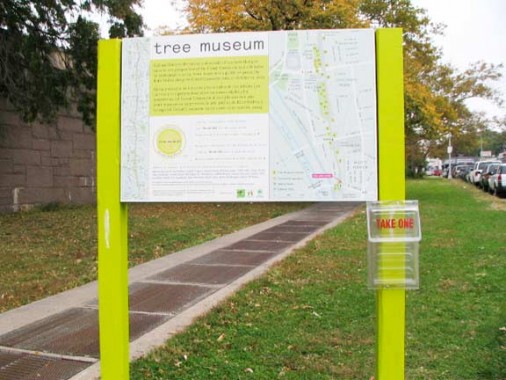




















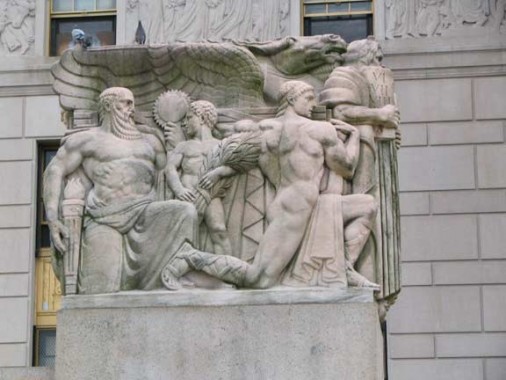






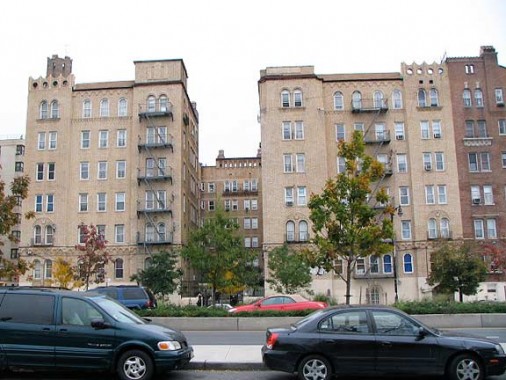






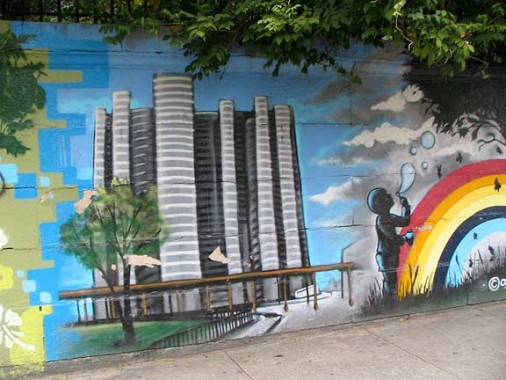





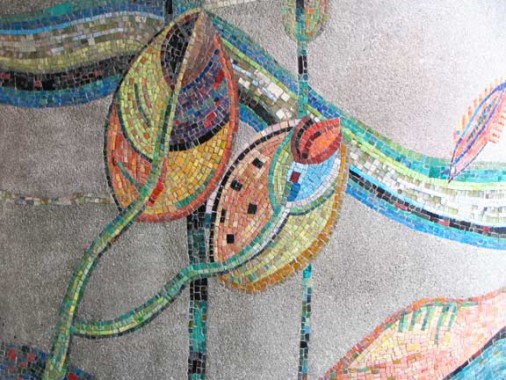


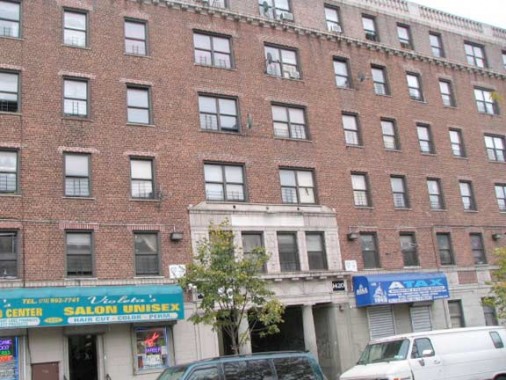

















34 comments
Isn’t 1118 G.C. a housing court – not family court?
Steve is correct. 1118 Grand Concourse is, in fact, New York City Housing Court.
It’s also one of the taller buildings that forms the skyline of the Bronx when seen from the upper deck of 1 East 161st Street, the fake Yankee Stadium.
During the ’50’s and ’60’s, 1118 Grand Concourse was the OLD family court building. I spent many a day in the old building when my father was seeking visitation rights to us. The building was eventually demolished and in its place is the new building which now is home to housing court. I was on 161st Street & Sheridan Ave about a year and half ago for my disability hearing which was across the street from the new family court building on 161st Street and Sheridan Ave and is around the corner from the criminal court building.
Re 888 Grand Concourse, do you have a shot of the ceiling mosaic itself? Thanks.
Unfortunately I did not get it
One of your best yet, Kevin. Brought back tons of memories…my Dad’s family lived along the Concourse around 170th St and I spent much of my childhood weekends there discovering the steep streets (and wonderful pizza for 25 cents a slice with a soda)
Hey Todd my name is Robert Kraut ,I lived on 171 st by Wythe Place. Was the pizza place Bills Pizza ? I remember 15 cents a slice and a soda for a dime.
Thanks, Kevin. You may make apartment hunting easier if all goes well.
Rita Moreno also has won an Emmy.(Wikipedia)
Adolph Weinman was also responsible for and is most noted as creating the beautiful stone work for the original Pennsylvania Station in NYC.
Most of his eagles aand some of the other statues are still in existence.
2 eagles flank the 7th ave entrance to Penn station still and one of the heads is on display until October 30th at the NYC Transit Museum annex in Grand Central Terminal.
David Richard Berkowitz (born Richard David Falco; June 1, 1953), aka Son of Sam and the .44 Caliber Killer was employed as a clerk at the U.S. Postal Office at 149th St & Grand Concourse while on his murderous rampage in the 1970’s. A sad but true part of the history of the lower Grand Concourse.
Joel mailed me these wonderful shots of the Concourse. I love them. The architechture was amazing. My doctor, Lewis London was in one of those buildings on the concourse. He had a seperate entrance so you didn’t have to go through the bldg. lobby. Wish I knew the address.
Thanks so much Kevin for all your amazing work, having been raised in Bronx in 50s and 60s and not living in the city for many years now i just thrill at looing at the pictures and reading historical blurbs. The photos of many of the places of my childhood are visual poetry to me. Again thanks so much for your historical and amazing work,
I lived on !88th and walked to the subway entrance on the Concourse every day, to go to work. I loved shopping in Alexander’s where you could get beautiful designer knock offs for $30.00. A lot of money in the mid 60’s but worth every penny. My rent was $65.00 and I loved my three room apt. It was very roomy compared to what people are buying now in
Manhattan. I miss it and the times.Now I live on the west coast.
Many memories as this was “my neighborhood” 1942-1963 but pictures cannot retell the lives & loves—-come & gone, your choice.
Just a correction on the Temple Adath Israel paragraph. It should say “now a Seventh-day Adventist Temple, going by the name of Grand Concourse Seventh-day Adventist Temple.” (no connection with Jehovah’s witness)… Please correct. Thank you.
these pictures are great. i am just getting around to seeing them. i lived at 1150 and it wasn’t to my memory called the fish building……. it was the fish house. at least that’s what my mother told cab drivers and we always got there. thanks
i went to ps 90 and jordan L mott,ps 22 and then taft.
walked the streets and enjoyed all the years spent being
a bronxite. it is in my blood, as it is with many many bronx
people. I feel i can speak for many of my old classmates
and neighbors. once a bronxite always a bronxite. loved it
all and still do.
I went to PS 90, Jordan L Mott, PS 22, and then Taft also, but in the 5th & 6 grades had to “do time” at ps 114 which I hated because I lived on the “wrong side” of the concourse unable to finish up at PS 90, but I will always claim PS 90 as mine. Lived at 1075 Grand Concourse from 1946 when I was born until 1969 when I moved to Manh and then to NJ. Such fond memories of the Bronx which I still consider my home.
Just realized this says its from “Anonymous.” That’s probably because I didn’t notice the spot to put my name in. This anonymous should have been Judi Fried
2121 Grand Concourse was built in 1936.
According to CUNY Lehman College, the Bronx County Courthouse was completed in 1934 (not 1931) and the architects are Max Hausle and Joseph Freedlander (not Friedlander).
Thanks so much for bringing back great memories. I grew up at 960 Grand Concourse, and moved to Executive Towers when it was built in the 1960s. My Bar Mitzvah was up the street at Young Israel of the Concourse.
Thanks for the fine “walk-uptown” overview.
But do note the important fact that Tracey Towers was designed by Paul Rudolph. He chaired the Yale Architecture School for some years, including the period when i was a grad student there. I’m not a huge Rudolph fan – but he certainly deserves design credit for his work! Thanks.
(Your website hasn’t ever been a website that I’ve located through a Google search of either the Grand Concourse or The Bronx. Just accidently found it by typing in a former friend’s name along with Sheridan Avenue in quotes.. Somehow try to remedy this with “Forgotten New York..
More former area residents I think would be appreciative.)
Anyway,
For Posting:
Terrific unexpected online discovery!
Ken Snyder
Wade JHS 117, 1965 and Taft HS, 1968.
I just wanted to provide an update: Sadly, PS 31 was demolished 2015 due to damage after Hurricane Sandy. 🙁
It’s shame the Theodore Roosevelt Apartments complex was stripped of its wonderfully ornate 1920s Spanish baroque stucco exterior in the late 1930s. There was even a bust or statue of Theodore Roosevelt in the courtyard, and the building started life as very fashionable with doormen, porters, etc. Stripping off its exterior (which had started to crumble) gave it a very bland appearance since it was not re-clad in the art deco or art moderne styles popular in the Bronx in the 30s. Very sadly, it became a total ruin by about 1970. How wonderful it would be to see it restored to its original 1922 appearance! I’ve just seen how the entire very ornate baroque city center of Dresden, totally flattened by bombing during WW2, Germany, has been completely restored to its original appearance, brick by brick. The final bits have just been finished, 70+ years later. Thank goodness almost all of the Concourse remains intact, having survived the wave of decay, vandalism and arson that destroyed so much of the Bronx in the 1970s.
Have any information on 1015 GrandConcourse?
Does anyone remember Guido’s Barber shop on the grand concourse. in the 60’s and 70’s?
1695 Grand Concourse huge bedrooms and high ceilings.
Anybody knows about, Naor Gallery on 2360 Grand Concourse or, I am looking for more information, likely;
What’s the year Naor Gallery has a busyness there?
Sorry, too much misinformation, omissions and general sloppiness. The Grand concourse (and Boulevard) deserves far more professionalism.
Where be you from Denver? Little knowledge! Infuriating little knowledge of the Grand Concourse, Bronx, or architecture. You do have “chutpah” though attempt it,
Tell me what you would like added.
Delia (Bridget) and John Murphy lived on theConcourse at 170th, I think around 1957-1970.
I remember a hill from the train at bottom of the hill (?Jerome?)
and the stores: pizza place on corner by the train station, a candy shop that sold fuzzy white kitten wind up toys, a butcher shop with sawdust on the floor. It was a walk up apartment and they were on floor five… I used to sneak up to the roof that had tar on it to jump rope…